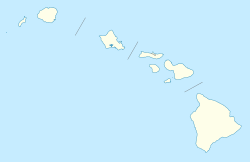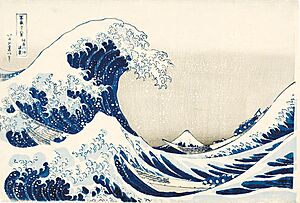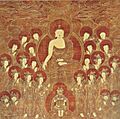Honolulu Museum of Art facts for kids
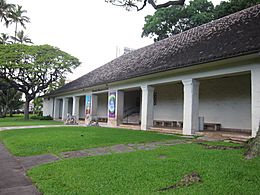 |
|
| Established | 1922 |
|---|---|
| Location | 900 South Beretania Street (between Ward and Victoria Streets), Honolulu, Hawaii |
|
Honolulu Academy of Arts
|
|
| Location | 900 S. Beretania St., Honolulu, Hawaii |
| Built | 1927 |
| Architect | Bertram Goodhue |
| Architectural style | Hawaiian |
| NRHP reference No. | 72000415 |
| Added to NRHP | March 25, 1972 |
The Honolulu Museum of Art is a large art museum in Honolulu, Hawaiʻi. It is the biggest museum of its kind in the state. The museum was started in 1922 by a woman named Anna Rice Cooke.
The museum is famous for having one of the largest collections of Asian and Pan-Pacific art in the United States. Since it opened on April 8, 1927, its collection has grown to include over 55,000 works of art. It's more than just a place to see art; it also has an art school, a movie theatre, a café, and a gift shop.
Contents
What Can You See at the Museum?
The Honolulu Museum of Art has a huge collection of art from all over the world. It is especially known for its amazing collection of art from Asia.
Art from Asia
The museum has more than 20,000 pieces of art from countries like Japan, China, Korea, India, and the Philippines. The collection includes beautiful paintings, sculptures, and textiles.
One of the most famous parts of the Asian art collection is the James A. Michener Collection. It has more than 10,000 Japanese ukiyo-e woodblock prints. Ukiyo-e is a style of Japanese art that was popular from the 17th to 19th centuries. This is the third-largest collection of its kind in the United States.
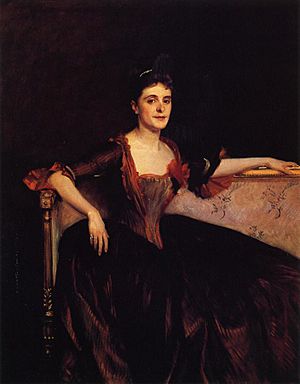
Art from Europe and America
The museum also has a great collection of European and American art. You can see paintings and sculptures from the Italian Renaissance all the way to modern times.
There are famous works by Impressionist and Post-Impressionist artists. These include paintings by Claude Monet, Vincent van Gogh, and Paul Gauguin. You can also find art by modern masters like Pablo Picasso, Henri Matisse, and Georgia O'Keeffe.
Art of Hawaiʻi
A special gallery in the museum is dedicated to the art of Hawaiʻi. It shows the history of art in the islands, from traditional Hawaiian arts to works by modern artists who live in Hawaiʻi. You can see how art in Hawaiʻi has changed over time.
The Story of the Museum
The Honolulu Museum of Art was founded by Anna Rice Cooke (1853–1934). She was born in Hawaiʻi to American missionary parents and grew up loving art. In 1874, she married Charles Montague Cooke, and they began collecting art for their home in Honolulu.
Their art collection grew so large that it filled their house. In 1920, Anna and her family decided to create a museum to share their collection with everyone in Hawaiʻi. She wanted the museum to celebrate the many different cultures of the islands.
A Special Building
The Cooke family donated their land and money to build the museum. The famous New York architect Bertram Goodhue designed the building. He created a beautiful Hawaiian-style building with open courtyards that connect the galleries. This design lets in fresh air and sunlight, making it a perfect place to enjoy art in Hawaiʻi's climate.
The museum officially opened on April 8, 1927. The opening celebration included a traditional Hawaiian blessing and music from the Royal Hawaiian Band.
Growing Over the Years
Over the years, the museum has grown. New wings were added for education, a library, and more gallery space. In 2011, another museum called The Contemporary Museum joined with the Honolulu Academy of Arts. A year later, the combined museum changed its name to the Honolulu Museum of Art.
Visiting the Museum
The museum is located near downtown Honolulu. It is open to the public from Wednesday to Sunday. Admission is free for children 18 and under.
Doris Duke Theatre
Inside the museum is the Doris Duke Theatre, which has 280 seats. It shows a variety of movies and also hosts concerts and talks.
Art School
The Honolulu Museum of Art School offers art classes and workshops for both children and adults. It has been an important part of the museum's mission to teach people about art since it opened.
Shangri La
The museum also has a partnership with Shangri La, the former home of Doris Duke. Shangri La is now a museum dedicated to Islamic art and design. Visitors can book tours to see its amazing collection.
Images for kids
See also
 In Spanish: Museo de Arte de Honolulu para niños
In Spanish: Museo de Arte de Honolulu para niños
- Gustav Ecke
- Honolulu Museum of Art School
- Richard Douglas Lane
- Shangri La (Doris Duke)
- Spalding House


